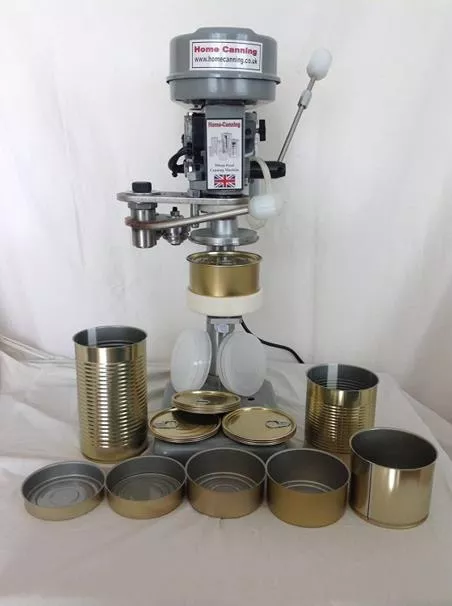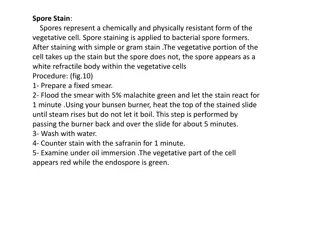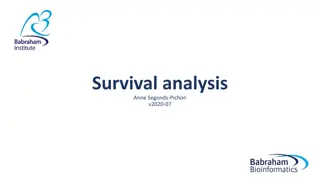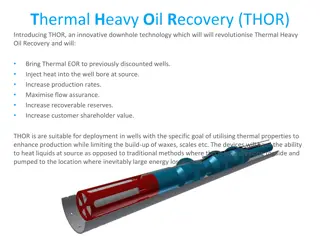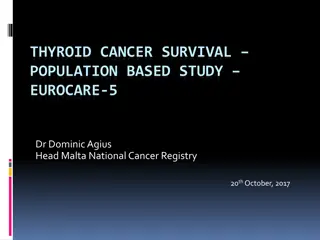Understanding Bacterial Spore Survival and Thermal Death Rates
Survival of bacterial spores during heat processing is crucial for food safety. The concept of Decimal Reduction Time (D value) and Thermal Death Time (TDT) curve help in understanding the thermal destruction of bacteria or spores. The Z value indicates the change in temperature necessary to cause a tenfold change in D value, with specific values for different organisms. This comprehensive analysis sheds light on the intricate process of bacterial spore survival and thermal death rates.
Download Presentation

Please find below an Image/Link to download the presentation.
The content on the website is provided AS IS for your information and personal use only. It may not be sold, licensed, or shared on other websites without obtaining consent from the author. Download presentation by click this link. If you encounter any issues during the download, it is possible that the publisher has removed the file from their server.
E N D
Presentation Transcript
D D- -Value, Z Value, Z- -Value, F Value, F- -Value & 12 Value & 12- -D Concept D Concept By Dr. Abhishek Thakur (Assistant Professor) College of Fisheries, Kishanganj BASU, Patna
Survival of Bacterial Spores during heat processing (Decimal Reduction) Thermal destruction of bacteria or spores takes place in definite pattern. Suspension of bacterial spores exposed to constant lethal temp. Logarithms of the number of the surviving spores are plotted against time on linear scale (or the number of survivors in a log scale against time in linear scale) a straight line graph will be obtained.
Thermal Death Rate Curve or Decimal Reduction Time Curve or Survival Curve The slope of the curve _ Decimal Reduction Time (D) or Death Rate. D is equal to time in minutes required to reduce the number of survivors to one tenth of the original at a specified temperature. Time required for the curve to traverse one log cycle. D121 C Higher the load longer the time.
D Value Organism Bacillus Stearothermophilus C. thermosaccharolyticum Desulfotomaculum nigrificancs Clostridium botulinum type A & B C. sporogenes (P.A. 3679) B. coagulans D value min @ 121.1 C 4-5 3-4 0.1 - 1.5 0.01 - 0.07 2-3 0.1-0.25
Thermal Death Time Curve Thermal death time (TDT) time in minutes required to inactivate an arbitory chosen number of spores of a given bacteria at a specified temperature. Thermal death time are plotted on log scale against corresponding temperature in linear scale. Logarithms of death times can be plotted against corresponding temperature, both on linear scale. A straight line graphs_ Thermal Death Time Curve (TDT curve)
Z Value The slope of the TDT curve is defined as Z which is equal to the number of degrees on the temperature scale when the curve traverse one log cycle. Z is the change in temperature necessary to cause a ten fold change in D-value. The value of Z for C. botulinum is 10 C Every 10 C change in temperature there is a ten fold change In its death rate. B. subtilis has Z value of 6.5
F Value Sterilizing value_ time in minutes required to kill an organism in a specific medium at 121.1 C (TDT). When the Z value of the process is 10 C, F is denoted as Fo. The unit of sterilization is Fo. Fo can be defined as the integrated heating effect received by all points inside the can. Fo value of 1 is equivalent to holding the product at 121.1 C for one minutes.
F Value Do for B. Stearothermophilus to be 5 min. & initial number (No) in the container to be 10,000, if it was required to reduce this number to one (Nt) in the heat process, four decimal reduction would be needed. The time at 121.1 would be 4 x Do = 4 x 5 = 20 min. the number of decimal reductions required is given by log No/Nt = logNo-logNt = 4-0 = 4 This log No/Nt some times refereed as order of process factor of m & the value of the product of m & Do is called Processvalue or Fvalue i.e. Fo=mDo
12 12- - D Concept D Concept Method of expressing process lethality requirement. Most frequently bacteria found in low acid as well as medium acid food is C. botulinum which is having ability to produce a deadly lethal toxin in the food. Therefore, the modern canning practices demands a reduction in C. botulinum spores by a factor of 1012 in such food. This means that probability of survival spores must be reduce to one can in a billion (i.e., 1012). Thus, if there were one spores of C. botulinum initially in the container.
12 12- - D Concept D Concept m = log No/Nt = log 1 log 1012 = 12 Fo = m Do = 12 x 0.21 = 2.52 min it is more correctly written F = 2.52 min. C. botulinum 121.1
12 12- - D Concept D Concept D value of C. botulinum = 0.21 Factor of 1012 = 12 x 0.21 = 2.52 min D= t loga- log b t= time of heating a= initial number of spores b=number of survivors


